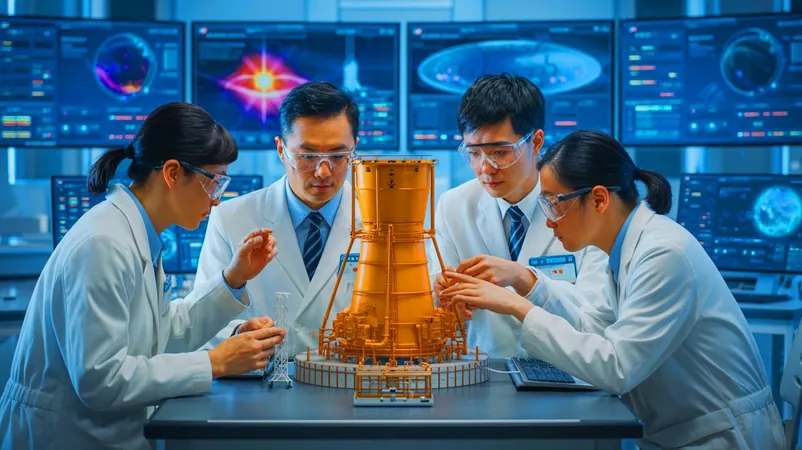
China Shakes Up the Moon Race: NASA's Reactor Flaw Could Delay U.S. Missions!
2025-06-01
Author: Nur
The New Space Race Heats Up
In an age where nations are vying to claim their stake in lunar exploration, the battle for supremacy on the Moon is hotter than ever. The U.S. and China are not just racing to explore the Moon; they're fighting to establish the first permanent base. Recent revelations from Chinese scientists about potential flaws in NASA's lunar nuclear reactor could dramatically change the game for America's ambitious lunar plans.
NASA's Fission Reactor at Risk?
As part of its Artemis program, NASA plans to return astronauts to the Moon and build sustainable infrastructure. However, new research from Chinese engineers has cast a shadow over these plans, revealing significant weaknesses in NASA’s Fission Surface Power (FSP) project. This 40-kilowatt reactor is vital for providing stable electricity during the infamous two-week lunar night—an essential function for powering equipment and habitats. Yet, Chinese experts from the China National Nuclear Corporation (CNNC) have flagged critical design issues that could compromise the project.
NASA's preference for highly enriched uranium fuel requires heavy beryllium shielding, making the reactor cumbersome for transport and installation on the Moon. On top of that, this fuel type is prone to radiation-induced swelling, jeopardizing the reactor's lifespan after just eight years. Concerns also arise over its rudimentary control mechanisms, raising alarms on safety in high-stakes scenarios.
China's Revolutionary Response
In reaction to these revelations, Chinese engineers are stepping up with their own refined lunar nuclear reactor model, taking cues from both the American design and the Soviet-era TOPAZ-II reactor. Their new approach appears to promise enhanced reliability, essential for long-duration lunar missions.
A groundbreaking change is the configuration of the fuel rods. Instead of traditional solid shapes, China opts for an annular design: hollow rings filled with uranium dioxide pellets encased in stainless steel. This configuration improves heat dissipation, crucial for maintaining optimal operating temperatures.
Additionally, the cooling system has been revamped, now using a liquid metal sodium-potassium alloy (NaK-78) that keeps temperatures below 1,112°F, effectively minimizing wear and tear and boosting the reactor's overall stability. Moreover, the control mechanisms have been upgraded, promising advanced safety measures that are vital for manned missions venturing far from Earth.
Implications for Lunar Exploration
These technological leaps signal China's ambition to lead in lunar exploration. By challenging the superiority of NASA’s designs, China could present a more sustainable solution for establishing a permanent lunar base. This emerging rivalry could not only alter current strategies but precipitate innovations that ultimately benefit all of humanity.
As the two superpowers compete, the race for lunar bases may pave the way for future missions to Mars and beyond, marking humanity's ascension as a truly spacefaring civilization.
A New Era for Space Exploration?
The revelations about NASA’s reactor weaknesses, coupled with China’s innovative solutions, add a new twist to the lunar race. As both nations work to refine their technologies, the world eagerly anticipates who will first secure a permanent foothold on the Moon.
These developments highlight the critical balance between international collaboration and competition in technological advancement. As we embark on a new chapter in space exploration, the question remains: Will these breakthroughs foster new partnerships, or will they escalate geopolitical tensions? In this exhilarating era, how will these innovations redefine what it means to venture into the cosmos?
 Brasil (PT)
Brasil (PT)
 Canada (EN)
Canada (EN)
 Chile (ES)
Chile (ES)
 Česko (CS)
Česko (CS)
 대한민국 (KO)
대한민국 (KO)
 España (ES)
España (ES)
 France (FR)
France (FR)
 Hong Kong (EN)
Hong Kong (EN)
 Italia (IT)
Italia (IT)
 日本 (JA)
日本 (JA)
 Magyarország (HU)
Magyarország (HU)
 Norge (NO)
Norge (NO)
 Polska (PL)
Polska (PL)
 Schweiz (DE)
Schweiz (DE)
 Singapore (EN)
Singapore (EN)
 Sverige (SV)
Sverige (SV)
 Suomi (FI)
Suomi (FI)
 Türkiye (TR)
Türkiye (TR)
 الإمارات العربية المتحدة (AR)
الإمارات العربية المتحدة (AR)